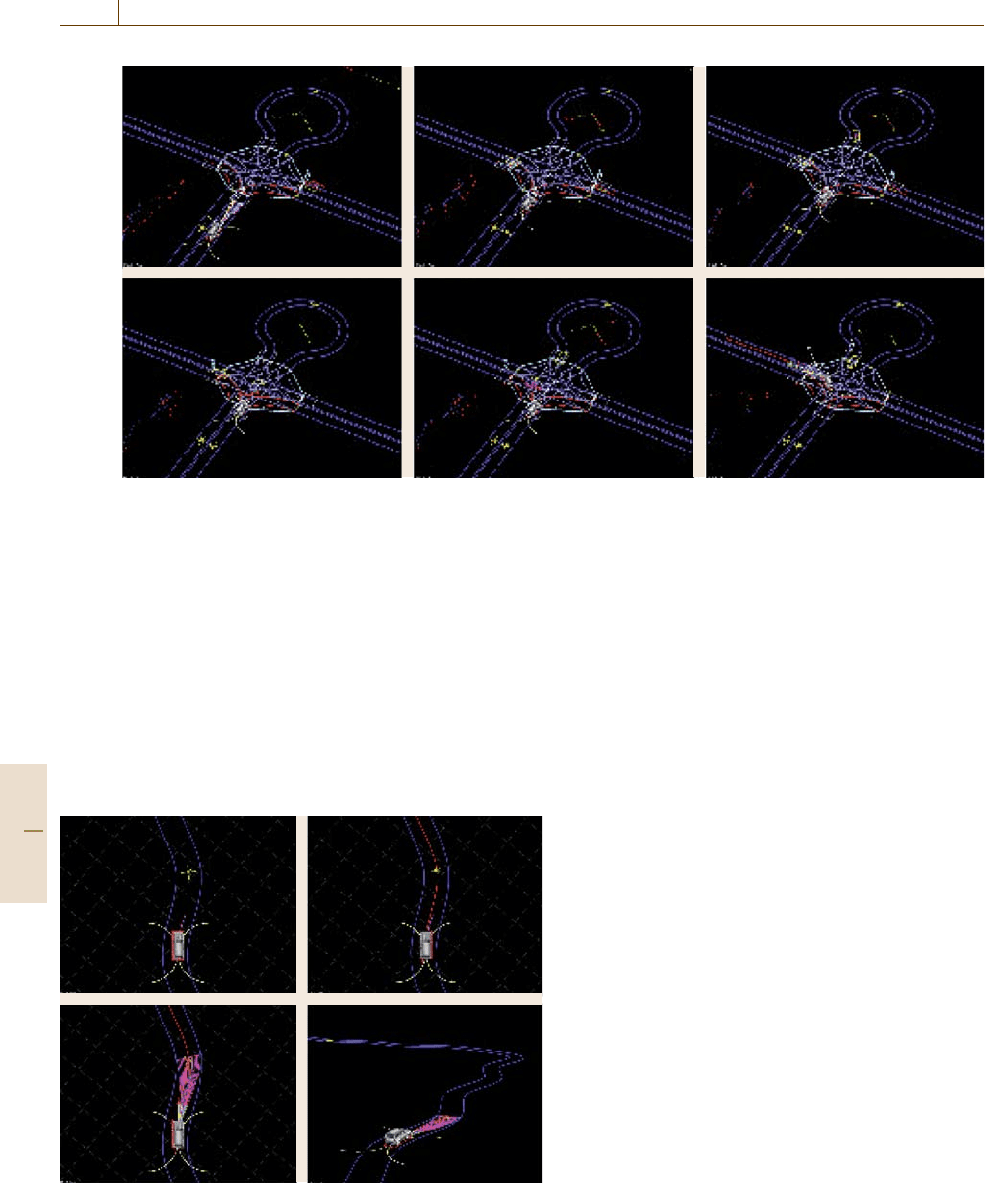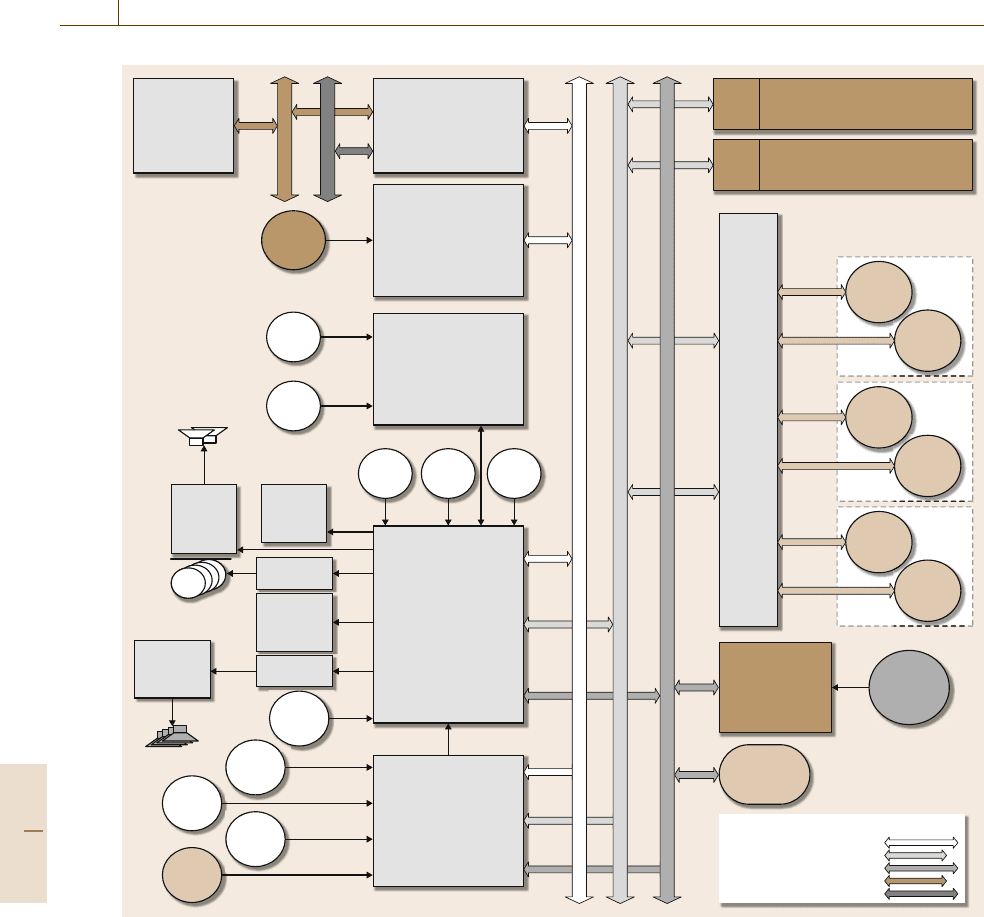Nof S.Y. Springer Handbook of Automation
Подождите немного. Документ загружается.


1165
Vehicle and R
66. Vehicle and Road Automation
Yuko J. Nakanishi
Presently in the USA, Europe, Japan, and in other
parts of the world, intelligent transportation sys-
tem (ITS) technologies are being developed and
deployed to increase the intelligence of vehicles.
The two key benefits of these technologies are en-
hancement of safety and mobility of the traveling
public. The intelligence is provided by electronics,
communications systems, software, and human–
machine interfaces and is assisting drivers with
many aspects of the driving task. Drivers may be
warned about potential crashes with other cars,
about objects that are hidden from their vantage
point, and about excessive speeds. Information
about real-time traffic conditions including inci-
dents on a driver’s preferred route, travel times to
specific destinations, and about restaurants, ho-
tels, and other destination points may be provided.
In-vehicle navigation systems can tell drivers how
to get to a destination on a turn-by-turn basis
and may be linked to a central dispatch cen-
ter to summon help automatically in case of an
accident.
The major initiatives and technologies being
developed in the USA – integrated vehicle-based
safety systems, forward collision warning systems,
road departure crash warning systems, vehicle
infrastructure integration – are described and
discussed in this chapter. In addition, how they
66.1 Background .........................................1165
66.1.1 USA – Intelligent Transportation
Systems (ITS) Background ............ 1165
66.1.2 European Union –
Telematics Initiatives .................. 1169
66.1.3 Japan – ITS Initiatives................. 1170
66.2 Integrated Vehicle-Based Safety Systems
(IVBSS) .................................................1171
66.2.1 IVBSS Systems Architecture........... 1171
66.2.2 Forward Collision Warning (FCW)
System...................................... 1173
66.2.3 Road Departure Crash Warning
(RDCW) System ...........................1174
66.2.4 Human Factors........................... 1174
66.3 Vehicle Infrastructure Integration (VII)....1176
66.3.1 VII Benefits................................ 1176
66.3.2 VII Risks .................................... 1177
66.4 Conclusion and Emerging Trends ...........1177
66.5 Further Reading ...................................1178
References ..................................................1180
interact with the driver is important in terms of
safety, liability, and acceptance of the technolo-
gies. The human factors elements that should be
considered are presented and discussed in the
chapter as well.
66.1 Background
66.1.1 USA – Intelligent Transportation
Systems (ITS) Background
In the USA, there were 5973000 police-reported motor
vehicle traffic accidents in 2006. These crashes resulted
in 42642 deaths and 2575000 injuries. During 2006,
an average of 117 persons died daily as a result of
these crashes. There were another 4 189000 accidents
involving property damage only [66.1]. While the fatal-
ity rate has decreased from 1.69 per 100million vehicle
miles of travel (VMT) in 1996 to 1.41 in 2006, these
statistics are still staggering and reflect the very serious
economic and human costs of these accidents. (Na-
tional HighwayTraffic Safety Administration (NHTSA,
Part G 66

1166 Part G Infrastructure and Service Automation
http://www.nhtsa.dot.gov/) reports that, in 2000, the
economic costs of traffic accidents were US$230.6 bil-
lion.)
The latest mobility research by the Texas Trans-
portation Institute concluded that traffic conges-
tion continues to worsen in US cities and causes
4.2billion hours of delays, depletes US$78 billion from
the US economy, and wastes 2.9billion gallons of fuel.
In 2005, congestion in urban areas caused the average
peak period traveler to spend an extra 38h of travel time
and consume an additional 26 gallons of fuel, at a cost
of US$710 per traveler [66.2].
Intelligent transportation systems (ITS)istheap-
plication of electronics, communications, information,
and information technology to transportation systems.
The primary drivers of these technologies are safety
and mobility. Concomitant benefits are efficiency, con-
venience, and accessibility. Highlights of safety and
mobility benefits generated by ITS projects are pre-
sented below [66.3].
Safety benefits:
•
In Georgia, the Navigator incident management pro-
gram reduced secondary crashes from an expected
676 to 210 in the 12 months ending April 2004
(2006).
•
In North Carolina, a work zone equipped with smart
work zone traveler information systems observed
fewer crashes compared with other work zones
without the technology (2005).
•
In Baltimore, a second train coming warning sys-
tem decreased the frequency of the most common
risky behavior at crossings (i.e., drivers that crossed
the tracks after the protection gates began to as-
cend from the first train before the protection gates
could be redeployed for the second train) by 26%
(2002).
•
Evaluation indicated that integrating dynamic mes-
sage signs (DMS) and incident management sys-
tems could reduce crashes by 2.8%, and that
integrating DMS and arterial traffic control systems
could decrease crashes by 2%, in San Antonio, TX
(2000).
•
In Georgia, call boxes installed on a 39mile section
of I-185 were estimated to eliminate one injury per
year, and one fatality every 5years (2000).
•
An advanced curve warning system on an interstate
route in northern California caused over 68% of
drivers to reduce their speed (2000).
•
In a rural area of Virginia, a collision countermea-
sure system installed on a two-way stop-controlled
intersection reduced vehicle speeds by 2.4mi/h,
and increasedthe average projectedtime to collision
from 2.5to3.5s (2000).
•
An automated enforcement systems in California
decreased highway–rail grade crossingviolations by
up to 92% (1999).
•
A dynamic truck downhill speed warning system
installed on I-70 in Colorado reduced the average
speed of passing trucks by approximately 5.2mi/h
(1999).
•
In Colorado, a downhill truck speed warning sys-
tem installed on I-70 reduced runaway ramp usage
by 24% and contributed to a 13% drop in crashes
involving trucks and excessive speeds (1997).
•
After a ramp rollover warning system was installed
at three curved exit ramps on the beltway around
Washington, DC, there were no accidents at any
of these sites during the 3year postdeployment test
period evaluated (1997).
•
Following deployment of the TransGuide freeway
management system in San Antonio, TX, crash fre-
quency was reduced by 41% and incident response
time decreased by 20% (1997).
•
Advanced traffic management systems in Amster-
dam and Germany reduced crash rates by 20–23%
(1999).
•
In Japan, a real-time incident detection and warning
system installed on a dangerous curve on the Han-
shin Expressway decreased the rate of secondary
crashes by 50% (1997).
Mobility benefits [66.3]:
•
In Georgia, the Navigator incident management pro-
gram reduced the average incident duration from
67minto21min,saving7.25million vehicle-hours
of delay over one year (2006).
•
In Georgia, the highway emergency response
operator (HERO) motorist assistance patrol pro-
gram and Navigator incident management activities
saved more than 187million USdollars, yielding
a benefit-to-cost ratio of 4.4:1 (2006).
•
In Utah, incident management teams in Salt Lake
Valley area decreased incident duration by approxi-
mately 20 min perincident on threemajor interstates
(2004).
•
In 2002, the Maryland coordinated highways
action response team (CHART) highway inci-
dent management program reduced delay by
about 30 millionvehicle−hours and saved about
5million gallons of fuel (2003).
Part G 66.1

Vehicle and Road Automation 66.1 Background 1167
•
In Albuquerque, NM, work zone surveillance and
response at the Big I Interchange reduced average
clearance time by 44% (2001).
•
During the first year of operations at the Big I work
zone in Albuquerque, temporary traffic management
and motorist assistance patrols reduced the average
incident response time to less than 8 min, and no
fatalities were reported (2001).
•
Modeling performed as part of an evaluation of nine
ITS implementation projects in San Antonio, TX,
indicated that integrating dynamic message signs
(DMS), incident management, and arterial traffic
control systems could reduce delay by 5.9% (2000).
•
The delay reduction benefits of improved incident
management in the Greater Houston area saved
motorists approximately US$8440 000 annually
(1997).
•
In San Antonio, TX, a freeway management
system led to an estimated delay savings of
700vehicle−hours per major incident (1997).
•
In Brooklyn, an incident management system on
the Gowanusand Prospect Expressways used closed
circuit television (CCTV), highway advisory radio,
DMS, and a construction information hotline to im-
prove average incident clearance time by about 1 h,
a 66% improvement (1997).
The National ITS Architecture [66.4] provides a com-
mon framework for the planning defining and imple-
mentation of ITS, and definesthe requiredfunctions, the
physical entities or subsystems where these functions
reside, and the information flows and data flows link-
ing these functions and physical subsystems together.
The National ITS Architecture consists of three layers,
institutional, communications, and transportation:
•
Institutional layer: represents the existing and
emerging institutional constraints and arrangements
and addresses policy issues, funding incentives,
working arrangements, and jurisdictional structure.
•
Communications layer: comprises communication
equipment such as wireless transmitters and re-
ceivers.
a) b) c)
Fig. 66.1 (a) Collision avoidance system. (b) Driver assis-
tance system.
(c) Collision notification system
•
Transportation layer: presents relationships among
the transportation-related elements, including trav-
eler subsystems, vehicles, transportation manage-
ment centers field devices, and external system
interfaces.
Logical architecture defines ITS processes, process-
to-process data flows, and data elements and is not
technology specific. Physical architecture is the high-
level structure containing major ITS system compo-
nents. Subsystems are the structural elements of the
physical architecture. The subsystems are categorized
into center, traveler, field, and vehicles [66.5].
The intelligent vehicles subsystem is comprised of
collision avoidance systems, driver assistance systems,
and collision notification systems (Fig.66.1).
Collision avoidance systems (CAS) warn drivers of
impending danger. The vehicle warnings need to occur
early enough for the driver to take action, and must also
be clear and understandable to the driver. Since multi-
ple alarms would be confusing and distracting for the
driver, a management system needs to be present to de-
cide which CAS or driver assistance warning to provide
when the condition warrants it. CAS systems comprise
the following elements:
•
Intersection collision warning systems detect and
warn drivers of approaching traffic at high-speed
intersections; these systems use both vehicle- and
infrastructure-based technologies. Once vehicle in-
frastructure integration is in place, other drivers
would also be able to receive warnings about im-
pending violations (Fig.66.2).
•
Obstacle detection systems use vehicle-mounted
sensors to detect obstructions, such as other vehi-
cles, road debris or animals, in a vehicle’s path and
alert thedriver. Anexample of a more advanced sys-
tem for obstacle detection and road navigation in
intelligent vehicles is presented in Fig.66.3.
•
Lane-change warning systems have been deployed
to alert bus and truck drivers of vehicles or obstruc-
tions in adjacent lanes when the driver prepares to
change lanes.
•
Lane departure warning systems warn drivers that
their vehicle is unintentionally drifting out of the
lane.
•
Rollover warning systems notify drivers of heavy
trucks when they are traveling too fast for an
approaching curve, given their vehicles operating
characteristics. This system would also be useful for
light trucks (sports utility vehicles (SUVs)) as well.
Part G 66.1

1168 Part G Infrastructure and Service Automation
a) b) c)
d) e) f)
Fig. 66.2 (a) The robot approaches an intersection and identifies a waiting car (rectangle marked by a blue diamond).
As the gets closer
(b) it detects a second vehicle (rectangle, left of frame), and upon coming to a stop (c) tracks a third
vehicle, which arrives late (rectangle middle of frame).
(d) The first vehicle begins moving through the intersection, and
precedence is transferred to the second vehicle, denoted by the teal diamond.
(e) The second vehicle begins traversing the
intersection.
(f) Upon all clear, the robot takes precedence ahead of the third vehicle and safely navigates the intersection
(courtesy of Tartan Racing, Carnegie Mellon University)
•
Road departure warning systems have been tested
using machine vision and other in-vehicle systems
to detect and alert drivers of potentially unsafe lane-
keeping practices and to keep drowsy drivers from
running off the road.
•
Forward collision warning systems use microwave
radar and machine vision technology to help de-
a) b)
c) d)
tect and avert crashes. Drivers are warned of unsafe
conditions via vehicle displays or audible alerts. If
a driver does not properly apply brakes in a crit-
ical situation, some systems automatically assume
control and apply the brakes in an attempt to avoid
a collision.
•
Rear-impact warning systems use radar detection to
prevent accidents. A warning sign is activated on
the rear of the vehicle to warn tailgating drivers of
impending danger.
Driver assistance systems (DAS) assist drivers nav-
igate their vehicles safely, enhance their vision, and
control the speed of their vehicles. These systems will
Fig. 66.3 (a) Vehicle navigating down a single-lane road
(lane boundaries shown in blue, current curvature of the
vehicle shown in pink, minimum turning radius arcs shown
in yellow).
(b) extracted centerline of the lane (in red).
(c) candidate trajectories generated by the vehicle given
its current state, the centerline path, and lane bound-
aries. A single trajectory is selected for execution, as
discussed.
(d) the same scenario from an alternative view-
ing angle (courtesy of Tartan Racing, Carnegie Mellon
University)
Part G 66.1

Vehicle and Road Automation 66.1 Background 1169
be especially valuable in inclement weather or in other
hazardous conditions. Driver assistance systems com-
prise:
•
In-vehicle navigation and route guidance systems
with global positioning system (GPS) technology
may reduce driver error, increase safety, and save
time by improving driver decision in unfamiliar ar-
eas.
•
Integrated driver communication systems enable
drivers and dispatchers to coordinate rerouting deci-
sions on-the-fly and can also save time and money,
and improve productivity.
•
In-vehicle vision enhancement improves visibility
for driving conditions involving reduced sight dis-
tance due to night driving, inadequate lighting, fog,
drifting snow or other inclement weather condi-
tions.
•
Object detection systems warn the driver of an ob-
ject (front, side or back) that is in the path or
adjacent to the path of the vehicle. Currently the
most common application is parking aids for pas-
senger vehicles. Toyota’s intelligent parking assist
(IPA) system uses cameras and sensors to steer the
car for the driver for parallel parking or backing into
a parking space. Obstacle detection sensors for rear
and forward bumpers are available from automakers
or available from individual vendors.
•
Adaptive cruise control systems maintain a driver
set speed without a lead vehicle, or a specified
following time if there is a lead vehicle and it is
traveling slower than the set speed.
•
Intelligent speed control systems limit maximum
vehicle speed via a signal from the infrastructure to
an equipped vehicle.
•
Lane keeping assistance systems can make minor
steering corrections if the vehicle detects an immi-
nent lane departure without the use of a turn signal.
•
Roll stability control systems take corrective action,
such as throttle control or braking, when sensors de-
tect that a vehicle is in a potential rollover situation.
•
Drowsy driver warning alerts drivers when they
have become fatigued.
•
Precision docking systems automate precise posi-
tioning of vehicles at loading/unloading areas.
•
Coupling/decoupling: intelligent cruise control,
speed control, guidance/steering, and coupling/de-
coupling systems which help transit operators link
multiple buses or train cars into trains each as-
sist drivers with routine tasks that weight on driver
workload.
•
Onboard monitoring tracks and reports cargo con-
dition, safety, and security, and the mechanical
condition of vehicles equipped with in-vehicle di-
agnostics. This information can be presented to the
driver immediately, transmitted off-board, or stored.
In case ofa crashor near-crash, in-vehicle eventdata
recorders can record vehicle performance data and
other input from cameras or sensors.
Collision notification systems (CNS)suchasGM’s
Onstar system report accidents to emergency respon-
ders or dispatch centers either manually (MAYDAY)
or automatically with automatic collision notification
(ACN). Details about the accident such as its severity
and number of passengers inside the vehicle may also
be reported.
•
MAYDAY/ACN products utilize location technology,
wireless communication, and a third-party response
center to notify the closest public safety answering
point (PSAP) for emergency response.
•
Advanced ACN systems use in-vehicle crash sen-
sors, GPStechnology, and wireless communications
systems to supply public/private call centers with
crash location information, and in some cases, the
number of injured passengers and the nature of their
injuries.
Additional information and ITS initiatives in the
USA are providedin subsequentsections ofthis chapter.
66.1.2 European Union –
Telematics Initiatives
In Europe, telematics is the equivalent of ITS technolo-
gies, and the key benefits being sought by the European
countries are similar. The European Commission seeks
to further reduce road fatalities by 50% by 2010. To
accomplish this, preventive safety systems are being de-
veloped within various Europe-wide initiatives such as
eSafety and PReVENT.
The eSafety effort established by the European
Commission contains nine working groups which focus
on crash-causation analysis, human–machine interface,
and others. First-generation or autonomous systems
within the vehicle act as isolated units with minimal in-
teraction among the units and minimal external input.
The core technologies are:
•
Advanced vehicle sensors and communications sys-
tems that integrate with onboard navigation systems
•
Advanced GPS coordinates with digital mapping
and location-based services
Part G 66.1

1170 Part G Infrastructure and Service Automation
•
Vehicle and infrastructure information,emphasizing
safety and efficiency
Second-generation initiatives such as PReVENT
manage the vehicle’s performance in the context
of the overall system, with the vehicle and infras-
tructure working together to enhance the safety of
motorists [66.6].
PReVENT systems are being designed to be in-
teroperable across European nations and even on
a global basis. PReVENT technologies will predict
the behavior of traffic and other drivers, and include
sensing technologies, in-vehicle digital map and po-
sitioning technologies, and wireless communications
systems. The technologies revolve around provision
of driver-oriented safety applications. A key element
of PReVENT is advanced driver assistance systems
(ADAS), whichwas originally initiated as aresult of the
EUREKA programme for an European traffic of highest
efficiency and unprecedented safety (PROMETHEUS)
project [66.7].
•
The 3year MAPS&ADAS subproject has produced
an ADAS interface, ADAS maps for PReVENT test
sites, and a safety impact assessment of the maps.
This project isneeded becauseaccess to map databy
applications other than navigation requires a stan-
dard nonproprietary interface.
•
The ProFusion subproject focuses on sensors and
sensor data fusion. The first preliminary concept
building phase has been completed. The objectives
of the second phase are:
– To develop concepts and methods for sensor
data fusion to improve the reliability and robust-
ness of perception systems
– To define and implement a flexible and modu-
lar architecture for fusion systems with diverse
approaches
– To establish and maintain the Fusion Forum,
which promotes sensor data fusion in driver as-
sistance and active safety systems
•
RESPONSE 3 will develop a code of practice for
the development and testing of ADAS for European
industry and will address the key issues of reason-
able safety and duty of care by defining safe ADAS
development and testing.
•
PReVAL subproject will provide PReVENT with
a common evaluation framework and methodology
to assess the impact of various applications.
•
INSAFES (integrated safety system) is developing
new control functions to improve the functionality
of applications already developed.
•
The 3 year WILLWARN (wireless local danger
warning) subproject will generate a safety applica-
tion that warns the driver whenever a safety-related
critical situation occurs beyond the driver’s field
of view. The application will include the develop-
ment of onboard hazard detection, in-car warning
management, and decentralized warning distribu-
tion by vehicle-to-vehicle communication on a road
network
•
The SASPENCE (safe speed and distance) system
will guide the driver regarding desirable speed and
headway for the given driving conditions.
66.1.3 Japan – ITS Initiatives
In Japan, the focus of ITS efforts has initially been on
in-vehicle information systems, and the benefits sought
have been in terms of safety and the environment. As in
Europe, there has been strong national leadership with
regards to achieving these benefits. In comparison with
other nations, Japan has many vendors of ITS-related
products and services.
The vehicle information and communication system
(VICS) is a real-time system that provides information
including weather, road and traffic conditions, and nav-
igation assistance to in-vehicle navigation systems. The
system has been considered a great success with more
than 9million subscribers in 2004. While the VICS ser-
vice is free, users pay a one-timesetup fee,and purchase
the onboard navigation system. This system serves as
a catalyst for further ITS deployment in automobiles.
Taxi probes equipped with GPS and wiper sensors are
used by the Japan Road Traffic Information Center to
obtain information about the transportation system; the
information is then analyzed and passed along to mo-
torists using VICS. A mobile radio local-area network
in the 2.4GHz bandwidth was installed by the Japan
Highway Public Corporation and is used to commu-
nicate both data and images to in-vehicle navigation
systems [66.6].
Other technologies that have been developed in-
clude the following:
•
Vehicles equipped with cameras to allow drivers
to see objects and roadway features in blind spots.
This technology is an element of advanced cruise-
assisted highway systems (AHS), which provide
information on highway features (curve data or
other roadway information) as well as warnings of
obstacles. AHS warns drivers of impending dangers
and allows a timely response to them.
Part G 66.1

Vehicle and Road Automation 66.2 Integrated Vehicle-Based Safety Systems (IVBSS) 1171
•
The radar cruise control (with low-speed following
mode) system enables drivers to adjust headway be-
tween their own vehicle and the one immediately
ahead, thereby providing uniform traffic flow and
automatic adjustment of speed based on the actions
of the lead vehicle. Adaptive cruise control provides
the added benefit of mild to increasingly intense
braking if the driver of a vehicle does not respond
safely to a slowing or stopping vehicle ahead.
The remainder of the chapter will discuss specific
ITS initiatives established in the USA.
66.2 Integrated Vehicle-Based Safety Systems (IVBSS)
The Integrated Vehicle-Based Safety Systems (IVBSS)
initiative addresses the subset of accidents caused by
rear-ending, road departures, and lane changes. The
initiative involves the development of objective tests
and criteria for performance of IVBSS, and how best
to communicate an integrated warning to the driver.
IVBSS is expected to have the potential to reduce these
accidents by almost 50%, which translates into about
21000 lives saved per year.
The IVBSS program will evaluate the safety ben-
efits and driver acceptance of the following crash
warning subsystems [66.8]:
•
Forward crash warning, which warns light vehicle
and heavy truck drivers of the potential for a rear-
end crash with another vehicle
•
Lateral drift warning, which warns light vehicle and
heavy truck drivers that they may be drifting inad-
vertently from their lane or departing the roadway
•
Lane-change/merge warning, which warns light ve-
hicle and heavy truck drivers of possible unsafe
lateral maneuvers based on adjacent or approach-
ing vehicles in adjacent lanes, andincludes full-time
side object presence indicators
•
Curve-speed warning, which warns light vehicle
and heavy truck drivers they may be driving too
quickly into an upcoming curve
The two main functions of IVBSS are situation
characterization, which determines that a potential
crash threat exists, and threat assessment, which de-
termines whether an alert should be issued for each
warning subsystem. The major elements of IVBSS are
as follows [66.8].
•
Sensing subject vehicle information and driver con-
trol inputs: The IVBSS system must obtain certain
information from the vehicle; for example, for rear-
end crashes, vehicle speed, yaw rate, and driver
brake switch are important.
•
Sensing roadway geometry and characteristics:Ob-
taining information about the roadway (e.g., road
curvature, vehicle axes relative to the lane, position
of the vehicle in the lane, determination of whether
the lane edges are road edges, time rate of change of
the lateral position of the vehicle relative to the road
edge).
•
Sensing objects and characterizing object type and
motion: To avoidcrashes, identification and location
of other vehicles in the same lane and in adjacent
lanes are important.
•
Estimating road condition parameters: Each warn-
ing function is required to obtain and use available
data that may indicate low road friction.
•
Sensing driver attributes: In the subsequent year of
the research, individual driver behavior will be in-
tegrated into decisions about the issuance of crash
alerts.
US Department of Transport (DOT)-sponsored ef-
forts have produced driver–vehicle interfaces including
visual and auditory display requirements; specific warn-
ing messages have been identified and are under
development; human factors tests were conducted to
test the interfaces and the system itself; and prototype
hardware was developed for the IVBSS evaluation.
US DOT-sponsored field tests of forward crash
warning (FCW) systems for light vehicles in the Colli-
sion Avoidance Metrics Partnership (CAMP) program
which produced performance criteria for radar-based
FCW crash warning systems [66.9]. Further FCW
crash warning systems research was performed in the
Automotive Collision Avoidance Systems (ACAS)pro-
gram [66.10–12].
66.2.1 IVBSS Systems Architecture
The systems architecture diagram shown in Fig. 66.4
displays the major subsystems along with the sensors
and software, and the hardware interfaces and commu-
nication protocols of the IVBSS.
The five major elements of the architecture (to the
left of the buses) are:
Part G 66.2

1172 Part G Infrastructure and Service Automation
Headrest
speakers
Digital
map
Warning
enabled
Inertial
sensors
Driver
face
camera
Cellular
antenna
Shared
cameras
GPS
antenna
Rear
right
back
Rear
left
back
Short-range radar
Short-range
forward
camera
(CMOS)
Front long
range
camera
(CMOS)
IVBSS system CAN bus (600K)
LCM CAN bus (600K)
FCW CAN bus (600K)
Vehicle CAN bus – high speed
Vehicle CAN bus – low speed
Snooze Volume
Sensi-
tivity
CMOS
camera
Gateway
Vehicle
stability
assist
Right side vision module
CMOS
camera
Left side vision module
Lateral drift
warning
(LDW)
module
AMP
Side
mirror
(icons)
OEM
audio
system
Haptic
controller
Curve speed
warning
(CSW)
module
Lane change/merge
FCW
arbitration
DVI (LFAD) module
Data acquisition
system (DAS)
module
Forward
vision
platform
Bus legend
Range processing unit (RPU)
Front
left
side
Front
right
side
Rear
left
side
Front long
range radar
Rear
right
side
Vehicle CAN bus – low speed
Vehicle CAN bus – high speed
FCW CAN bus (600K)
LCM CAN bus (600K)
IVBSS system CAN bus (600K)
IVBSS
driver
display
Audio
controller
Yaw rate
sensor
Fig. 66.4 IVBSS system architecture (after [66.8])
•
Gateway: Translatesappropriate messagesfrom two
original equipment manufacturer (OEM) data buses
to one of the project CAN buses
•
Lateral drift warning module: Uses forward vision-
based lane tracking and other signals from the CAN
bus to broadcast LDW (lane departure warning)
alert requests onto the bus
•
Curve speed warning module:UsesGPS, an on-
board digital map, and other information to broad-
cast CSW alert requests onto a serial link to the
LFAD (light-vehicle module for LCM, FCW, arbi-
tration, and DVI) module
•
LCM (lane change/merge warning)/FCW/arbitra-
tion/DVI (driver-vehicle interface) module: A chas-
sis that includes processors and other hardware
on which LCM, FCW, arbitration, and DVI are
hosted
•
Data-acquisition system module: A two-central pro-
cessing unit (CPU) module with peripherals that
records data.
Part G 66.2

Vehicle and Road Automation 66.2 Integrated Vehicle-Based Safety Systems (IVBSS) 1173
The additional elements above the three IVBSS
CAN buses include two vision-based modules that as-
sist with LCM functionality on the left and right side
of the vehicle and a third vision-based module that as-
sists FCW target selection and three pairs of short-range
radars communicating with the IVBSS CAN buses
through a radar processing unit (RPU).
66.2.2 Forward Collision Warning (FCW)
System
Forward collision warning (FCW) systems warn the
driver when the vehicle is about to crash into the rear-
end of another vehicle or object. FCW systems use
sensors such as radar, GPS, and vehicle-to-vehicle com-
munications systems in combination with appropriate
algorithms to detect static and moving obstacles and
determine when to issue an alert request. The request
is forwarded to an arbitration subsystem which re-
ceives requests from all driver warning systems and
decides which warning to issue. The two important
driver behavior parameters are: driver brake reaction
time – the time required for the driver to respond to
the alert by braking – and driver deceleration behavior
in response to the alert under a wide range of condi-
tions [66.9].
Figure 66.5 depicts a cooperative FCW application.
The host vehicle, equipped with the FCW system,
can transmit and receive dedicated short range commu-
nications (DSRC) messages while only target vehicle 2
Fig. 66.5 Cooperative forward collision warning applica-
tion (www.nhtsa.gov)
has a similar DSRC messaging system. The host ve-
hicle’s system will scan vehicles in its sensing area,
choose the closest in-path target, and analyze the tar-
get’s dynamics information. If the target is a threat,
a warning will be sent to the driver of the target vehicle.
Currently, FCW updates at 100ms and have coverage
ranges of 150m.
The system performance is enhanced by vehicles
that have DSRC due to the additional redundancy pro-
vided in vehicle detection. Redundancy is important
especially in adverse environmental (e.g., snow) con-
ditions. Dynamics information received from the target
vehicle is richer; information about vehicle size, type,
position, and turn-signal status can be transmitted to the
host vehicle. Also, the information is received with low
latency. Earlier detection of the target vehicle cutting
into the host vehicle’s path is possible due to informa-
tion about turn-signal status, steering wheel position,
and yaw rate. Conversely, false alarms may be reduced
by earlier detection of the target vehicle leaving the host
vehicle’s path.
Another benefit of DSRC-equipped vehicles is early
detection of stopped vehicles. Presently, it is not possi-
ble to identifystopped vehicles untilit is too lateto issue
a warning toprevent anaccident. A DSRC-equipped ve-
hicle can warn other vehicles that it is stopped. Once all
vehicles on the road are equipped with DSRC, sensors
would not be needed.
A Forward Collision Warning Requirements Project
sponsored by NHSTA sought to develop a FCW crash
alert timing approach by examining last-second brak-
ing and lane-change maneuvers. One finding was that
differences in last-second braking and steering were de-
pendent on kinematic conditions.
Two braking onset models were developed – one
using linear regression, and the other using logistic re-
gression.
1. The first model develops a deceleration value above
which the driver is assumed to be in alert mode
when the driver is about to brake. The inputs of the
model werethe closing speed between the following
and leading vehicle, the lead vehicle deceleration
value, and knowledge of whether or not the lead
vehicle is moving or stationary.
2. The second model is the three-tiered inverse time-
to-collision model which predicts the probability
that a driver is in an appropriate alert condition. The
model contains inverse time to collision which is the
difference in speeds of the following and leading
vehicles divided by the ranges between the vehicles.
Part G 66.2

1174 Part G Infrastructure and Service Automation
The FCW software modules are as follows:
1. Radar-based scene tracking: Tracks objects with re-
spect to the subject vehicle
2. Path prediction and data fusion: Determines the up-
coming geometry
3. Primary target determination: Determines the in-
lane primary target thatis considered the most likely
to pose a crash threat
4. Vision-based primary target validation and charac-
terization: Validates the choice of primary target,
and includes verification that the target is a relevant
vehicle
5. Threat assessment: Given the primary target, de-
cides whether to issue an FCW crash alert request
6. FCW false-alarm management: Manages false
alarms to reduce the nuisance alarm rate using his-
torical data and subsequent driver responses
66.2.3 Road Departure Crash Warning
(RDCW) System
Road departure accidents make up less than one-fifth
of accidents but cause almost 40% of annual highway
fatalities and are often caused by driver inattention,
intoxication or drowsiness. Road departure crash warn-
ing (RDCW) systems warn drivers of impending road
departure crashes due to lateral drift (unintentionally
moving into another lane) or excessive curve speeds.
The Intelligent Vehicle Initiative (IVI)RoadDe-
parture Crash Warning System Field Operational Test
(RDCW FOT) project conducted under a cooperative
agreement between the USDepartment of Transporta-
tion and the University of Michigan Transportation
Research Institute and its partners provided valuable in-
sights into driver behavior and the specific benefits of
the RDCW system which may be generalized to sim-
ilar systems. The RDCW system tested in the RDCW
FOT project targeted lane departure crashes as well as
vehicles traveling into curves at unsafe speeds [66.13].
The RDCW system architecture developed for the
project is shown in Fig.66.6.
The lateral drift warning system (LDW) provided
a set of driver alerts in the form of visual and haptic
seat vibrations when the vehicle started to drift towards
or outside of the lane boundaries; the driver was then
expected to assess the situations and take appropriate
action. The LDW system issued imminent alerts in the
form of a visual icon and audible message in more haz-
ardous conditions (e.g., when striking an object was
imminent).
The key primary sensors used by the LDW system
were forward cameras to identify the lane boundaries
and road edges, brake switch, and turn-signal switch.
Supporting equipment were GPS, a digital map and
database, vehicle speed, yaw-rate gyro, and forward-
and side-looking radars.
The three major changes effected by the LDW sys-
tem on driver behavior were all positive; these changes
were:
1. The rate of turn-signal use during lane changes in-
creased.
2. Lane keeping performance improved: The standard
deviation of lane position decreased significantly:
the number of events in which the outside of the
vehicle’s tire crossed the lane edge or came within
4inches of the lane edge was reduced by 50%. The
time spent within 4 inch of the lane edge or outside
the lane edge was reduced by 63%.
3. With the warning system in place, the data suggest
that the vehicle returns to the lane more quickly.
The curve speed warning system (CSW) warns
drivers to reduce speed before entering an upcoming
curve. The CSW system uses GPS and a digital map to
determine curve locations and radii. Recent driver ac-
tions such as applying turn signals were incorporated
into the system’s decision to issue an alert. The driver
warnings consisted of visual, audible, and haptic cues
similar to those of the LDW system.
In addition to GPS and a digital map, the CSW
system used vehicle speed and yaw-rate gyro as the pri-
mary sensors, while thesupporting equipment consisted
of the camera, brake switch, and turn-signal switch.
66.2.4 Human Factors
Background
Human factors research is an important aspect of vehi-
cle automation systems. Evaluation of driver interaction
with driver assistance systems such as in-vehicle navi-
gation systems, evaluation of different user interfaces
for the systems, and driver understanding of and reac-
tion times to collision warning systems are essential
in the development of a safe and effective technology.
According to NHTSA, driver distraction contributes to
20–30% of crashes, and in-vehicle navigation systems
and other systemsthat requiredriver attention willcause
driver distraction. A 2000 NHTSA study confirmed that
entering destinationsinto navigation systems along with
cellphone dialing and radio tuning were distracting to
the driver [66.14].
Part G 66.2
